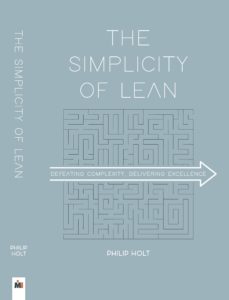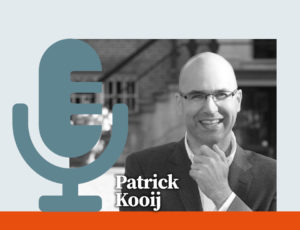
In zijn nieuwe boek ‘The simplicty of Lean’, introduceert Philip Holt het begrip hansei. Dit is een Japanse manier van zelfreflectie om te begrijpen wat er in een situatie misging en wat je hiervan kunt leren. In dit Engelstalige artikel legt Holt uit hoe Hansei past binnen de lean-filosofie.
Introduction to: The Simplicity of Lean
Lean means many things to many people and its success or failure is important to a large number of stakeholders: customers, employees, management, shareholders, suppliers, and society as a whole. Is Lean a toolkit? Is it about cost saving? Is it a way of thinking? Or is it a fundamental and strategic shift in the culture of an organisation?
The importance of this question to each of the stakeholders might appear different but essentially, getting the answer right will result in each of the stakeholders benefitting in a substantial way. Customers will see their services, quality and total cost of ownership improve, while employees will find their work more rewarding. Management will experience a more engaged workforce. Managers will practice an improved form of leadership, one that supports dynamic and effective teamwork and allows them to achieve the success that they desire.
The purpose of The Simplicity of Lean is to help the reader to get to the right answer, and to adopt Lean Thinking and Lean Leadership into their organisation.
Simplicity
I chose the title of the book to convey that Lean injects simplicity into an organisation. However, please don’t misunderstand from my use of the word simplicity, that deploying Lean into an organisation’s culture is easy, or that it is overtly simple. This is not the intention in my choice of the word. Rather it is because I truly believe in, and have experienced, the simplicity that Lean brings to an organisation.
Please don’t misunderstand my use of the word ‘simplicity’. Deploying Lean is never simple, but Lean brings simplicity to an organisation.
Nevertheless, the approach that one must take to achieve this simplicity will require the removal of significant complexity in the organisation, both in terms of complicated processes built up over many years, and the cultural norms of behaviour that will be well-rooted.
In fact, one of the most common mistakes that I observe organisations make in their deployment of Lean is the over-simplification of the approach that they take. As Albert Einstein famously said: “Things should be made as simple as possible but not any simpler”. The corollary, ‘but not any simpler’, is often omitted from the quotation, yet it is the most important part of simplicity, and inherent in the thinking contained within this book.
I am quite confident that as the reader progresses through the book, they will gain the knowledge that they require to establish just how they can integrate Lean thinking and Lean leadership into the fabric of their organisation’s culture, and answer the question, ‘What is Lean?’
Hansei
From an early age, Japanese children learn what the Japanese call ‘Hansei’, a form of self-reflection to understand what went wrong in a given situation and to learn from it. From their first social interactions at kindergarten, when a Japanese child behaves in a way deemed unacceptable to their teacher, they will be asked to take some Hansei time to think about what they have done wrong and then explain their reflections to their teacher, what they might do differently in the future.
Whilst it could be argued that children are often asked to ‘think about what you’ve done’ in Western society, it is much more common for the child to be told what it is that they did wrong and how they should adjust their behaviour to conform in the future. This differs from the approach taken with the Japanese school child.
Hansei as a habit
The habit of Hansei is probably one of the key differences between the Japanese and Western way of thinking. This may go some way toward explaining why problem solving in the form of the Deming or PDCA Cycle was adopted with such sustainability by a large number of Japanese companies, and resonates at every level in the organisation, from practical problem solving at the shop-fl oor level through to Hoshin Kanri at the board level.
The habit of Hansei is probably one of the key differences between the Japanese and Western way of thinking.
This way of reflecting on, and improving one’s performance (effectively personal practise of the check and act parts of the cycle), is central to Coaching Leadership, the fourth and final leadership style of the Lean Leader.
Practice and teach Hansei
The Lean Leader must be able to both practise and teach Hansei in order to garner the level of deep reflection that the Lean Organisation requires. When the Lean Leader is able to practise Hansei as a habit, a certain freedom of action is achieved, whereby they feel free to experiment with new approaches and accept challenges without the fear of failure. It is a liberating experience.
When the Lean Leader is able to practise Hansei as a habit, a certain freedom of action is achieved.
Write down your thoughts
To support your development of this practice, at the end of every chapter there is a blank page for your reflections. Hansei is an opportunity for “reflecting back on one’s self, one’s own action” and therefore provides the reader with a few moments to think about what they have just read and how it links to their own way of working and acting. Therefore, I would encourage that, at the end of each chapter, and before reading further, you take a pen and write down your thoughts:
In relation to your own way of working and actions, what are:
- Your key learning points?
- The changes that you could make?
- Current problems that they would help to solve?
By doing this at the end of every chapter, you will hopefully already be practising a key element of a Lean leader, that of being a continuous learner.
Bron: The Simplicity of Lean, Defeating Complexity, Delivering Excellence
Philip Holt

Philip Holt is Senior Vice President, Global Transformation, at GKN Aerospace and a Board Member of the Operational Excellence Society. He studied Engineering at Manchester Metropolitan University and Management at the Wharton School of Pennsylvania and the University of Warwick, was an engineer at Gillette and led the Lean Deployment worldwide at Philips for over twelve years. He achieved Lean Master status and has summarised his 30+ years of experience and insights into Lean Leadership in his previous book Leading with Lean and his most recent book, The Simplicity of Lean.

